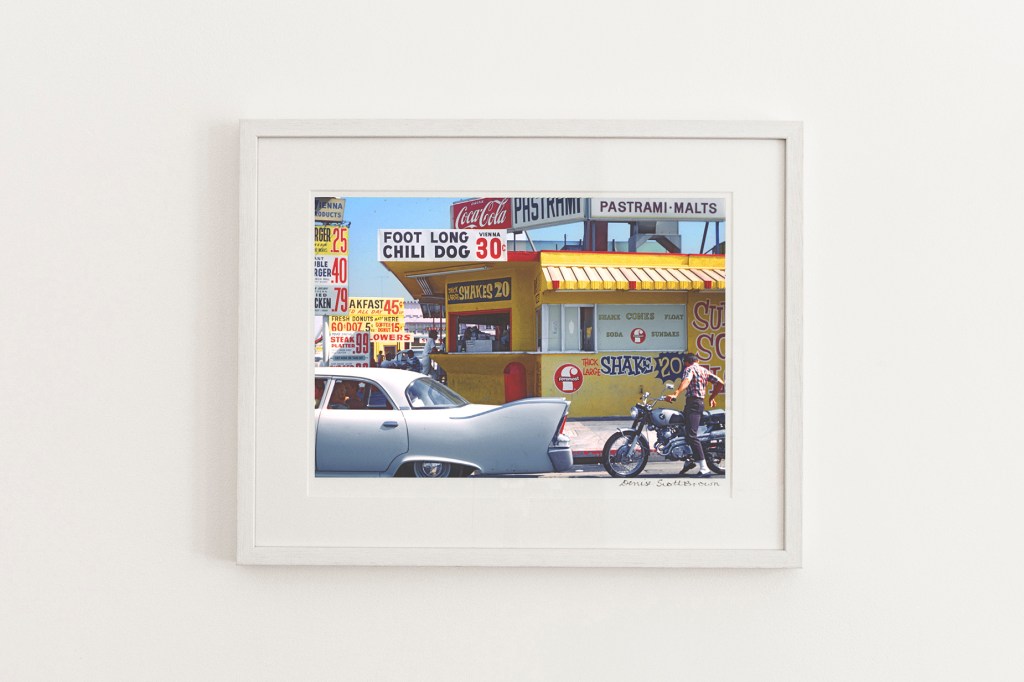When Denise Scott Brown shows you her photographs, she looks less at the images on the screen and more at you, her audience, taking them in. She notes what pleases you, what doesn’t, where your eyes are drawn. The silent interrogation might be unexpected—and occasionally formidable. But Scott Brown, Hon. FAIA, has long made an art of looking in untraditional places and directions. She faces you, not the screen.
Between 1956 and 1973, Scott Brown took roughly 11,000 photographs of buildings, villages, streets, storefronts, and skylines, to inform her research and teaching as well as to illustrate her articles and books. Today, these photographs are attracting newfound critical attention, both as an unexamined body of work from one of design’s most influential theorists and practitioners, and as a window into her craft, her “ethics of seeing,” to borrow Susan Sontag’s phrase about photography. Scott Brown’s photographs and her approach to urbanism and design reflect the same singular talent: an uncanny ability to know where to look.
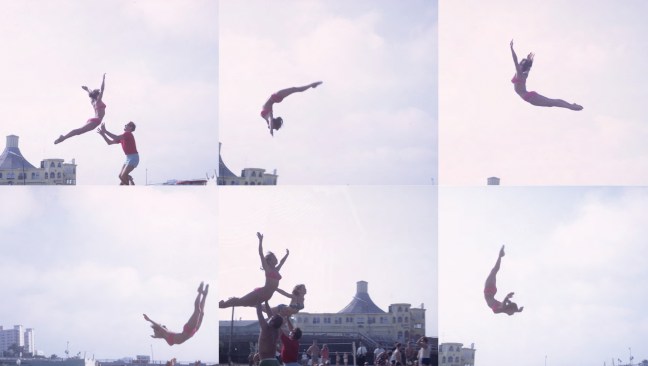
Denise Scott Brown
Santa Monica, Calif., 1968

Denise Scott Brown
Mojave Desert, c.1965
This summer, two London galleries, the Lethaby Gallery and the Betts Project (with help from Jeremy Eric Tenenbaum and PLANE—SITE), exhibited a broad selection of Scott Brown’s photographs: a yellow shake shack framed by a sea of signs on Pico Boulevard in Los Angeles; the Mojave Desert viewed from behind the dash of a rental car; unlit neon signage decorating the Las Vegas Strip. These shows were preceded by an installation at the 2016 Venice Biennale and will be followed by a larger exhibition on Scott Brown’s life and work opening in November at the Austrian museum of architecture in Vienna. The most exhaustive treatment will be a book of more than 500 images, titled Wayward Eye, which Scott Brown is currently compiling based on chronology, location, and her insights on urbanism.

Courtesy Betts Project
View of the Betts Project exhibition
Depicting the Demise of South Street
“You need to show the geometry and the proportions and the beauty of a building, but you need to show this as well,” Scott Brown says. We’re looking at a commercial strip of neon signs, broken and ragged; storefronts emptying but not abandoned; the worn blue façade of a modest street-corner church. In the 1960s, South Street was the commercial corridor and northern boundary of one of Philadelphia’s oldest African-American neighborhoods, but when it became the city’s favored route for a new highway, the Crosstown Expressway, businesses on South Street began to shutter. In the late ’60s, Scott Brown collaborated with local housing activists to design a new plan for the neighborhood that preserved existing buildings and added new housing, and that aspired to help city officials imagine how the area could thrive without the expressway. The activists defeated the highway proposal a few years later, but by then the neighborhood had already been decimated. Even though Scott Brown’s plan wasn’t implemented, it’s illustrative of the politically oriented planning and design work that she was drawn to early in her career, and how she used photography to investigate themes of power and class.

Denise Scott Brown
South Street, Philadelphia, mid-to-late 1960s
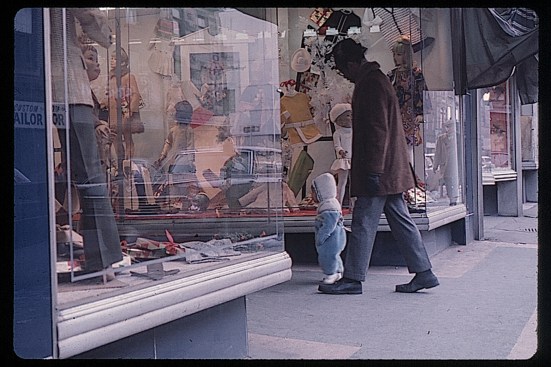
Denise Scott Brown
South Street, Philadelphia, mid-to-late 1960s

Denise Scott Brown
South Street, Philadelphia, mid-to-late 1960s
Scott Brown had moved to Philadelphia in 1958 to study at the University of Pennsylvania’s School of Design, whose faculty she joined three years later. It was in Philly that she had developed her interests in Main Street and the commercial vernacular, including billboards and signs, as well as her understanding of the intersections between architecture and political economy. She photographed both the city’s wealthy and its working-class districts, climbing stairs and gazing out windows to survey the context of entire streets: in one instance a residential block with two-story worker row houses, a hopscotch court drawn in chalk, and a large monolithic factory building rising behind the residents who congregated in the street.
One afternoon, Scott Brown experienced her “miracle”—a fortuitous moment that she ascribes to French photographer Henri Cartier-Bresson. “He says you just find something you like and you sit there with your camera and wait for a miracle, and the miracle will come. Well, my miracle came.” Scott Brown was sitting by a wall graffitied with the words “I love you.” The neighborhood was underserved and the wall poorly maintained, the message of love subversive. And then a group of school girls in white uniforms walked into the frame. As one stares ahead, another glances toward the lens; the orange on her dress collar matches the orange of the scrawl on the wall.

Denise Scott Brown
Philadelphia, 1961

Denise Scott Brown
Philadelphia, 1961
It’s a striking image, like many of Scott Brown’s photographs. But it’s the collection as a whole that best reveals her subjectivity: her love and understanding of patterns; her fascination with iconography; her dedication to the question and complexity of scale. In short, the collection reflects many of the concerns that informed her groundbreaking study of Las Vegas, which she conducted with her longtime partner Robert Venturi, FAIA, and Steven Izenour, and which transformed architecture—and art and culture more broadly. She met Venturi at Penn, where they taught together, shared notes, and critiqued one another’s work. When they left in 1965—he to Yale University and she to UC Berkeley and then to UCLA—she was already intrigued by the sprawling cities of the American West. When they married in 1967, Scott Brown was developing a studio on the Vegas Strip for UCLA; after the wedding, they moved it to Yale.
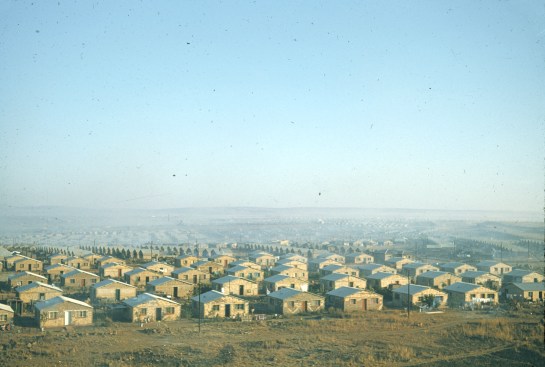
Denise Scott Brown
Soweto, Johannesburg, South Africa, c. 1956-7
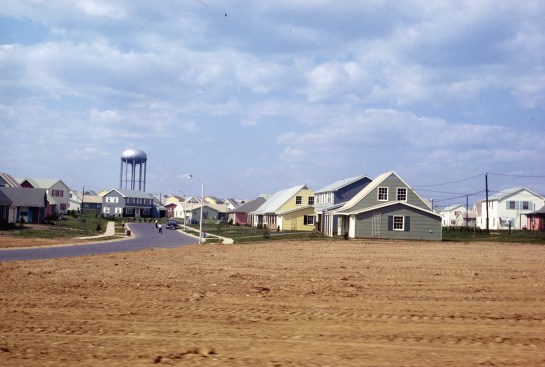
Denise Scott Brown
Maple Shade, N.J., 1963
Reversing an Earlier Erasure
During these heady, productive, contentious years, Scott Brown’s photography was often viewed as a pleasant-enough yet unserious pursuit. Real designers sketched—or so the conventional wisdom went (and often still goes). In 1968, when Scott Brown and Venturi published their first article on Las Vegas, in the journal Architectural Forum, about A&P Parking Lots, the editors printed these bios: “Mr. Venturi is the Philadelphia-based architect whose recent book Complexity and Contradiction in Architecture created a good deal of controversy at the time of its publication. Denise Scott Brown, who took most of the photographs accompanying this article including the one on our cover, is a teacher in architecture and urban design and an earlier contributor to ‘The Forum’. She is also Mrs. Venturi.”

Denise Scott Brown
Las Vegas, late 1960s
The bio perfectly encapsulates the prejudices of its era: Scott Brown is “a teacher” rather than a UCLA professor, and “Mrs. Venturi,” which was never her name. But before any of this we learn that she “took most of the photographs,” a sneaky little clause that constricts her contribution first and foremost to the images and, in turn, diminishes their import as well. In 1968, the design world placed little value on women or photography; grouping them together made a sort of undermining sense.
Today, Scott Brown’s photographs are helping to reverse the earlier erasure of her contributions—an erasure the photographs themselves once indirectly aided, which makes their current recognition almost poetic. It’s a recognition that comes at a moment when, perhaps for the first time, the male gaze is starting to lose its privileged position.

Denise Scott Brown
West Philadelphia, 1964
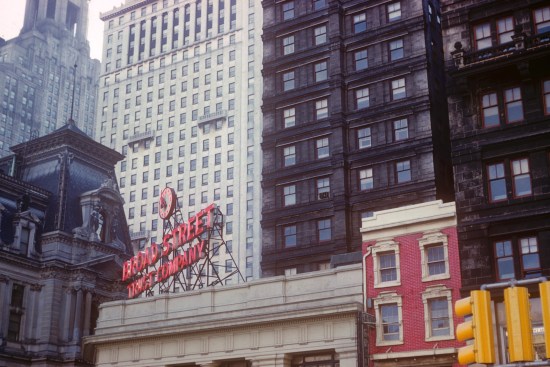
Denise Scott Brown
Center City Philadelphia, 1961

Denise Scott Brown
Philadelphia as seen across the Delaware River, 1963
Indeed, one particular photograph won’t appear in Scott Brown’s book or in any gallery frame: the photograph for which she is most famous, the one that Venturi took of her on their first trip to Vegas together, in 1966. Her power pose—legs wide, hands on hips—is an awesome, radical image; she’s depicted in a way that few women were then seen. But this is how someone else saw her, not what she was seeing through the lens.
So we only see the photograph that she took, moments before, of Venturi. They had been driving across the desert from L.A. when Scott Brown spotted three towers in descending height: the Dunes Hotel resort and casino flanked by its famous, spade-shaped sign and a sort of oversized brick chimney. She imagined Bob as a fourth tower, and decided to style him with his back to the camera—an anonymous, midcentury everyman looking toward the young city. It’s jarring to see the photograph alone; you instinctively search for its counterpart.
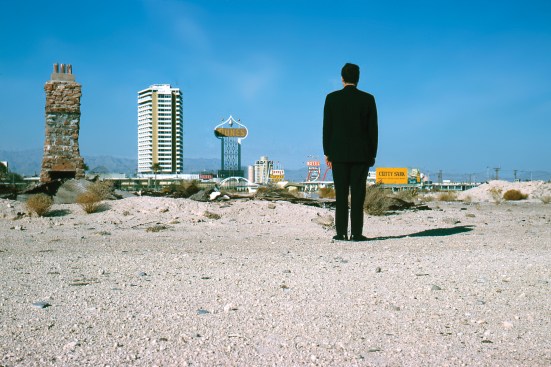
Denise Scott Brown
Las Vegas, 1966
But then you contemplate what Scott Brown was beginning to understand. Las Vegas wasn’t the sort of place that the architectural establishment paid much attention to back then; it was too crass and unrefined. But Scott Brown saw a sophistication to its architecture, a logic to its excess. Her gaze was playful—and prescient.
